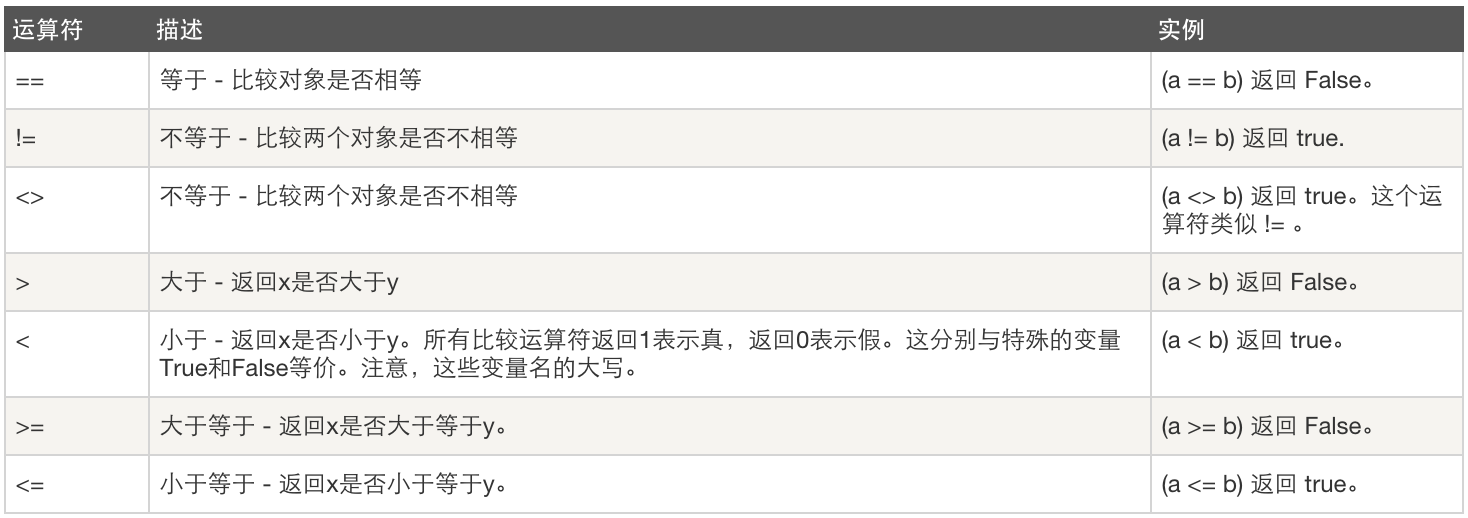变量、数据类型和运算符
本节目录
1、什么是变量?
2、常量
3、数字类型
4、布尔值
5、空值
6、运算符
什么是变量?
变量是一种使用方便的占位符,用于引用计算机内存地址,使用变量并不需要了解变量在计算机内存中的地址,只要通过变量名引用变量就可以查看或更改变量的值(简单的说,变量就是一个用来存储数据的容器,方便后面的调用)
#声明变量
name=“Li”
上述代码声明了一个变量,变量名为: name,变量name的值为:"Li"
在Python中,等号=是赋值语句,可以把任意数据类型赋值给变量,同一个变量可以反复赋值,而且可以是不同类型的变量。这种变量本身类型不固定的语言称之为动态语言,与之对应的是静态语言。静态语言在定义变量时必须指定变量类型,如果赋值的时候类型不匹配,就会报错。例如Java是静态语言,和静态语言相比,动态语言更灵活,就是这个原因。

常量
所谓常量就是不能变的变量,比如常用的数学常数π就是一个常量。在Python中,通常用全部大写的变量名表示常量:
PI=3.1415926
但事实上PI仍然是一个变量,Python根本没有任何机制保证PI不会被改变,所以,用全部大写的变量名表示常量只是一个习惯上的用法,如果你一定要改变变量PI的值,也没人能拦住你。
数字类型
1、整数(int)
Python可以处理任意大小的整数,当然包括负整数,在程序中的表示方法和数学上的写法一模一样,例如:1,100,-8080,0,等等。
计算机由于使用二进制,所以,有时候用十六进制表示整数比较方便,十六进制用0x前缀和0-9,a-f表示,例如:0xff00,0xa5b4c3d2,等等

class int(object): """ int(x=0) -> int or long int(x, base=10) -> int or long Convert a number or string to an integer, or return 0 if no arguments are given. If x is floating point, the conversion truncates towards zero. If x is outside the integer range, the function returns a long instead. If x is not a number or if base is given, then x must be a string or Unicode object representing an integer literal in the given base. The literal can be preceded by '+' or '-' and be surrounded by whitespace. The base defaults to 10. Valid bases are 0 and 2-36. Base 0 means to interpret the base from the string as an integer literal. >>> int('0b100', base=0) 4 """ def bit_length(self): """ 返回表示该数字的时占用的最少位数 """ """ int.bit_length() -> int Number of bits necessary to represent self in binary. >>> bin(37) '0b100101' >>> (37).bit_length() 6 """ return 0 def conjugate(self, *args, **kwargs): # real signature unknown """ 返回该复数的共轭复数 """ """ Returns self, the complex conjugate of any int. """ pass def __abs__(self): """ 返回绝对值 """ """ x.__abs__() <==> abs(x) """ pass def __add__(self, y): """ x.__add__(y) <==> x+y """ pass def __and__(self, y): """ x.__and__(y) <==> x&y """ pass def __cmp__(self, y): """ 比较两个数大小 """ """ x.__cmp__(y) <==> cmp(x,y) """ pass def __coerce__(self, y): """ 强制生成一个元组 """ """ x.__coerce__(y) <==> coerce(x, y) """ pass def __divmod__(self, y): """ 相除,得到商和余数组成的元组 """ """ x.__divmod__(y) <==> divmod(x, y) """ pass def __div__(self, y): """ x.__div__(y) <==> x/y """ pass def __float__(self): """ 转换为浮点类型 """ """ x.__float__() <==> float(x) """ pass def __floordiv__(self, y): """ x.__floordiv__(y) <==> x//y """ pass def __format__(self, *args, **kwargs): # real signature unknown pass def __getattribute__(self, name): """ x.__getattribute__('name') <==> x.name """ pass def __getnewargs__(self, *args, **kwargs): # real signature unknown """ 内部调用 __new__方法或创建对象时传入参数使用 """ pass def __hash__(self): """如果对象object为哈希表类型,返回对象object的哈希值。哈希值为整数。在字典查找中,哈希值用于快速比较字典的键。两个数值如果相等,则哈希值也相等。""" """ x.__hash__() <==> hash(x) """ pass def __hex__(self): """ 返回当前数的 十六进制 表示 """ """ x.__hex__() <==> hex(x) """ pass def __index__(self): """ 用于切片,数字无意义 """ """ x[y:z] <==> x[y.__index__():z.__index__()] """ pass def __init__(self, x, base=10): # known special case of int.__init__ """ 构造方法,执行 x = 123 或 x = int(10) 时,自动调用,暂时忽略 """ """ int(x=0) -> int or long int(x, base=10) -> int or long Convert a number or string to an integer, or return 0 if no arguments are given. If x is floating point, the conversion truncates towards zero. If x is outside the integer range, the function returns a long instead. If x is not a number or if base is given, then x must be a string or Unicode object representing an integer literal in the given base. The literal can be preceded by '+' or '-' and be surrounded by whitespace. The base defaults to 10. Valid bases are 0 and 2-36. Base 0 means to interpret the base from the string as an integer literal. >>> int('0b100', base=0) 4 # (copied from class doc) """ pass def __int__(self): """ 转换为整数 """ """ x.__int__() <==> int(x) """ pass def __invert__(self): """ x.__invert__() <==> ~x """ pass def __long__(self): """ 转换为长整数 """ """ x.__long__() <==> long(x) """ pass def __lshift__(self, y): """ x.__lshift__(y) <==> x<<y """ pass def __mod__(self, y): """ x.__mod__(y) <==> x%y """ pass def __mul__(self, y): """ x.__mul__(y) <==> x*y """ pass def __neg__(self): """ x.__neg__() <==> -x """ pass @staticmethod # known case of __new__ def __new__(S, *more): """ T.__new__(S, ...) -> a new object with type S, a subtype of T """ pass def __nonzero__(self): """ x.__nonzero__() <==> x != 0 """ pass def __oct__(self): """ 返回改值的 八进制 表示 """ """ x.__oct__() <==> oct(x) """ pass def __or__(self, y): """ x.__or__(y) <==> x|y """ pass def __pos__(self): """ x.__pos__() <==> +x """ pass def __pow__(self, y, z=None): """ 幂,次方 """ """ x.__pow__(y[, z]) <==> pow(x, y[, z]) """ pass def __radd__(self, y): """ x.__radd__(y) <==> y+x """ pass def __rand__(self, y): """ x.__rand__(y) <==> y&x """ pass def __rdivmod__(self, y): """ x.__rdivmod__(y) <==> divmod(y, x) """ pass def __rdiv__(self, y): """ x.__rdiv__(y) <==> y/x """ pass def __repr__(self): """转化为解释器可读取的形式 """ """ x.__repr__() <==> repr(x) """ pass def __str__(self): """转换为人阅读的形式,如果没有适于人阅读的解释形式的话,则返回解释器课阅读的形式""" """ x.__str__() <==> str(x) """ pass def __rfloordiv__(self, y): """ x.__rfloordiv__(y) <==> y//x """ pass def __rlshift__(self, y): """ x.__rlshift__(y) <==> y<<x """ pass def __rmod__(self, y): """ x.__rmod__(y) <==> y%x """ pass def __rmul__(self, y): """ x.__rmul__(y) <==> y*x """ pass def __ror__(self, y): """ x.__ror__(y) <==> y|x """ pass def __rpow__(self, x, z=None): """ y.__rpow__(x[, z]) <==> pow(x, y[, z]) """ pass def __rrshift__(self, y): """ x.__rrshift__(y) <==> y>>x """ pass def __rshift__(self, y): """ x.__rshift__(y) <==> x>>y """ pass def __rsub__(self, y): """ x.__rsub__(y) <==> y-x """ pass def __rtruediv__(self, y): """ x.__rtruediv__(y) <==> y/x """ pass def __rxor__(self, y): """ x.__rxor__(y) <==> y^x """ pass def __sub__(self, y): """ x.__sub__(y) <==> x-y """ pass def __truediv__(self, y): """ x.__truediv__(y) <==> x/y """ pass def __trunc__(self, *args, **kwargs): """ 返回数值被截取为整形的值,在整形中无意义 """ pass def __xor__(self, y): """ x.__xor__(y) <==> x^y """ pass denominator = property(lambda self: object(), lambda self, v: None, lambda self: None) # default """ 分母 = 1 """ """the denominator of a rational number in lowest terms""" imag = property(lambda self: object(), lambda self, v: None, lambda self: None) # default """ 虚数,无意义 """ """the imaginary part of a complex number""" numerator = property(lambda self: object(), lambda self, v: None, lambda self: None) # default """ 分子 = 数字大小 """ """the numerator of a rational number in lowest terms""" real = property(lambda self: object(), lambda self, v: None, lambda self: None) # default """ 实属,无意义 """ """the real part of a complex number""" 复制代码
2、浮点数(float)
浮点数也就是小数,之所以称为浮点数,是因为按照科学记数法表示时,一个浮点数的小数点位置是可变的,比如,1.23x109和12.3x108是完全相等的。浮点数可以用数学写法,如1.23,3.14,-9.01,等等。但是对于很大或很小的浮点数,就必须用科学计数法表示,把10用e替代,1.23x109就是1.23e9,或者12.3e8,0.000012可以写成1.2e-5,等等。
整数和浮点数在计算机内部存储的方式是不同的,整数运算永远是精确的(除法难道也是精确的?是的!),而浮点数运算则可能会有四舍五入的误差。
3、复数(complex)
与数学中的复数概念一致,z=a+bj,a是实数部分,b是虚数部分,a和b都是浮点数类型,虚数部分用j或J标识
例:5.6+3j, -8.2+9j
这三种类型存在一种逐渐“扩展”的关系:整数->浮点数->复数(整数是浮点数的特例,浮点数是复数的特例)
不同的数字类型可以进行混合运算,运算后生成结果为最宽类型
例:
#(整数+浮点数=浮点数) >>> 125+2.0 127.0
布尔值
布尔值和布尔代数的表示完全一致,一个布尔值只有True、False两种值,要么是True,要么是False,在Python中,可以直接用True、False表示布尔值(请注意大小写),也可以通过布尔运算计算出来:
>> True True >>> False False >>> 8> 9 False >>> 6> 5 True
布尔值可以用and、or和not运算。and运算是与运算,只有所有都为True,and运算结果才是True:
空值
空值是Python里一个特殊的值,用None表示。None不能理解为0,因为0是有意义的,而None是一个特殊的空值。
运算符

2、比较运算:

3、赋值运算:

4、逻辑运算:

5、成员运算:





